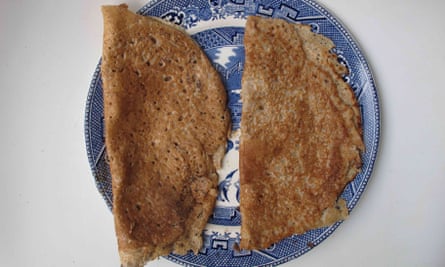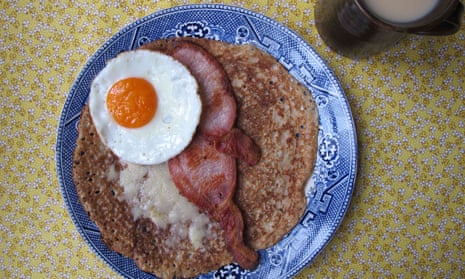Shrove Tuesday may have been and gone, the annual greasy round wiped from the kitchen ceiling, the dog back on non-burnt offerings – but this is one pancake that deserves to stay on the menu all year round. These floppy flatbreads are just as delicious as their crisp Scottish cousins, and certainly make a better bacon butty.
The Guardian’s product and service reviews are independent and are in no way influenced by any advertiser or commercial initiative. We will earn a commission from the retailer if you buy something through an affiliate link. Learn more.
Though there are spurious links to India, with claims that the local oatcake was inspired by the chapatis the North Staffordshire regiment enjoyed while stationed there in the days of the Raj, in fact oat breads were already a staple food in Britain’s uplands before her empire was even a twinkle in a megalomaniac’s bloodthirsty eye. They were quick to produce on the hearth in the days before domestic ovens were commonplace, and Sir Humphry Davy noted in his 1813 work, Elements of Agricultural Chemistry, that “the Derbyshire miners in winter, prefer oatcakes to wheaten bread; finding that this kind of nourishment enables them to support their strength and perform their labour better”.
They were once sold from “holes in the wall” throughout the region, and specialist oatcake bakers are still going strong, each with its devoted band of fiercely loyal customers. But for those of us outside the area, the staffordshire oatcake, as it is often referred to, is a difficult beast to track down (I’m with Rose Prince in thinking that “there is something scandalous about supermarket bakery aisles groaning with pitta bread, tortilla wraps and naan but without a single traditional oatcake in sight”). Happily, however, they are not hard to master, and they make for a mighty fine weekend breakfast or tea, preferably topped with melted cheese. Once Lent is over, at least.

The flour
Although many early recipes seem to use oats alone, including the one published in the Burton Daily Mail in 1917, and that collected in Florence White’s 1932 Good Things in England, most modern oatcakes are made with a proportion of wheat flour as well, giving them a slightly lighter flavour and texture. The plain flour suggested by Stoke DJ and “oatcake obsessive” Terry Bossons will work, but the high-gluten bread variety preferred by Elizabeth David in her English Bread and Yeast Cookery, Mary-Anne Boermans and Marwood Yeatman will give your oatcakes a more elastic strength useful for wrapping them around a filling.
David recommends using the white kind, but testers prefer the flavour that comes from a mix of white and wholemeal in Boermans and Yeatman’s recipes. I have increased the ratio of oat to wheat flour slightly to give the cakes a more emphatically oaty flavour; if you can’t find finely ground oatmeal, follow Boermans’s advice and grind your own from porridge oats in the food processor or blender. (I like to leave them fairly coarse, because it gives the oatcakes a more interesting texture, but though this may have been the case in the past, commercially produced oatcakes these days tend to be fairly smooth.)

The liquid
Again, older recipes are generally more spartan, moistening the batter with water alone, but David, Yeatman and Boermans use equal parts milk and warm water, giving the oatcakes a richer flavour and slightly softer consistency. (Milk also precludes the need to add a pinch of sugar to help the yeast do its work, as some recipes recommend.)
Boermans prefers a “a batter that is rather thicker than the traditional, which results in a thicker oatcake. In my defence, it makes for a more durable oatcake which I can then turn easily in the pan without it breaking, and it ‘laces’ beautifully, the surface becoming dappled with the characteristic pockmarks and holes seen also on pikelets and crumpets. The thickness also allows for a wonderful contrast when toasted between the crisp outsides and the fluffy insides.” In fact, her oatcakes may well be closer to the original style than she realises: Yeatman notes in The Last Food of England that the oatcake has undergone a “change in identity” since going commercial. Once sourdough, mixed in wooden tubs “impregnated with years of barm and allowed to retain a little batter … which started the next fermentation … the modern oatcake, probably universal by 1914, is less than half the width, thinner, softer, regular and raised with compressed yeast”. However, I find a thinner batter much easier to work with.

The yeast
As Yeatman explains, oatcakes these days use manufactured, rather than wild yeast, though I would love to try a sourdough version if anyone has a tried-and-tested recipe. Most of the versions I try call for fresh yeast (available from bakers, or even at the bakery counter of large supermarkets), but no one can detect any difference in flavour between fresh and the dried yeast that goes into Boermans’s pancakes, so use whichever you find easiest to get hold of and work with.
Bossons also adds bicarbonate of soda and baking powder to his batter in a belt-and-braces approach that does indeed yield a lovely lacy texture, but also gives them a marked chemical flavour no one is very keen on. Whether this is intentional or not (bicarbonate of soda isn’t an uncommon ingredient), it doesn’t go down well here. If your batter isn’t bubbly enough without it, it may be time to buy some more yeast.
Extras
Laura Mason and Catherine Brown’s book, The Taste of Britain, mentions adding a little melted bacon fat to the batter. I give it a try in Prince’s recipe, but find it makes the batter rather soft and prone to falling apart when turned – better, we decide, to cook them in lard or bacon drippings if they’re available, or simply to serve them with the stuff instead. Clarified butter also works well, but you can use just about any fat you like given that the pan only needs to be lightly greased (though if you choose coconut oil, please don’t tell me about it).
Oatcakes can be as little or large as your heart desires (the small variety are known as “little dippers”, according to Yeatman) but Mason and Brown describe the standard kind as about 20cm in diameter, and 4mm thick. They are traditionally cooked on a hot bakestone of the kind also used to make Welsh cakes and crumpets, as well as Scottish oatcakes, but these days it is easiest to make them in the same hot frying pan you would use for any other pancake, though, given their size, I find it easiest to turn them with a plate rather than attempting to flip.
Serve with just about anything you like – although I would recommend them as a particularly delicious edible plate for a fry-up.

Makes 10 large oatcakes
450ml milk + 450ml warm water
250g finely ground oats (you can grind ordinary oats in a food processor)
100g strong wholemeal flour
100g strong white flour
1 tsp fine salt
4g dry yeast or 10g fresh yeast
Fat of your choice to cook (lard, bacon drippings, clarified butter, vegetable oil)
Heat the milk with the same amount of water in a pan until about blood temperature.
Meanwhile, mix the oats, flours and salt in a large bowl. Mix the yeast with a little of the warm liquid and then cover and leave until frothy. Stir into the dry ingredients and then whisk in the remaining liquid until smooth. Cover and leave in a warm place for about an hour until bubbly, or overnight in the fridge if you prefer.
Grease a large frying pan with a little fat and put on a medium-high heat. When hot enough for the batter to sizzle as it hits it, give the bowl a quick whisk, then add a ladleful to the pan and tilt to spread it out. Cook until dry on top, then loosen the edges and carefully turn it over (depending on the size, it may be easiest to flip it on to a plate or board slightly larger than the pan) then slide it back into the pan. Add any toppings you would like to melt or heat through (cheese, for example), and cook until golden on the bottom. Fold over and eat, or allow to cool then cover and store in the fridge or freezer, reheating in a dry pan before use.
Staffordshire, Derbyshire – wherever you learned to love them – how do you like to eat these generously sized oatcakes, who makes the best, and why on earth aren’t they better known outside the Potteries?

Comments (…)
Sign in or create your Guardian account to join the discussion